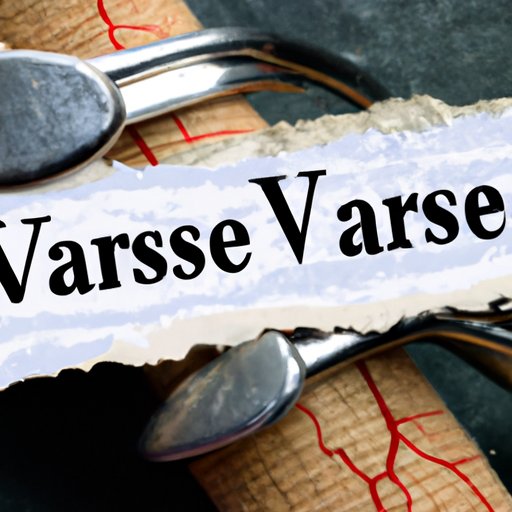
Introduction
Varicose veins are swollen and twisted veins that appear blue or purple and often protrude from the skin’s surface. The condition can be uncomfortable, causing pain and swelling, and can lead to more severe issues if left untreated. Varicose vein treatments range from non-invasive lifestyle changes to medical procedures, such as sclerotherapy and radiofrequency ablation. However, without insurance, the costs can be overwhelming. In this article, we will explore the costs of varicose vein treatment without insurance and provide tips on managing the expenses for people who are uninsured.
The Cost of Varicose Vein Treatment: How to Manage the Expenses without Insurance
Varicose vein treatment costs can vary widely, depending on the severity of the condition and the type of treatment. According to the Vein Clinics of America, the cost of laser treatment for varicose veins can range from $600 to $3000 per treatment. Sclerotherapy costs typically between $350 to $1000 per session, and radiofrequency ablation costs between $1500 to $3000 per treatment. However, these costs do not include the additional costs of consultations, tests, and follow-up appointments.
Without insurance, the costs can be overwhelming, but some tips may help. Shop around different treatment centers’ prices and even negotiate a payment plan or find financial aid offered by certain clinics. Furthermore, exploring affordable treatment options such as self-care practices and compression stockings may be more affordable than medical procedures.
A Comprehensive Guide to Budgeting for Varicose Vein Treatment when You Don’t Have Insurance
Once you have established your treatment plan, creating a budget to cover the expenses is key. Start by listing the costs of each procedure and include additional expenses, such as transportation costs, dietary supplements, and compression stockings. Calculate the total expenses and divide it by the number of months you plan to spread the payments over. Understanding the costs will help prioritize the budget and establish reasonable payment arrangements.
You can also cut costs by reviewing your expenses and finding areas where you can reduce expenses, such as food, entertainment or transportation to save for treatment expenses. Explore low-cost activities or DIY projects you can do to cut expenses without sacrificing your overall quality of life.
Affordable Varicose Vein Treatment Options for Those without Insurance
Lifestyle changes such as exercising regularly, losing weight, and elevating the legs can help improve varicose veins. Wearing compression stockings provide relief and are cost-effective and available over the counter. Furthermore, practitioners recommend occasionally massaging the legs to improve circulation. Do some research and review the existing self-care practices which are relatively inexpensive.
Inexpensive medical treatments are available but, instead of immediately going for the most expensive treatment options, starting with the most cost-effective varies. For instance, radiofrequency ablation costs more than sclerotherapy and may not be necessary, depending on the severity of the condition, making a consultation vital in identifying the best approach to take.
Navigating the Cost of Varicose Vein Treatment Without Insurance: Tips from a Healthcare Professional
Getting advice from a healthcare professional in accessing affordable varicose vein treatment is crucial. A practitioner can advise on the affordable options available to patients and offer suggestions on how to manage the expenses. Additionally, patients can choose to talk to their healthcare provider about payment options to make the treatment more manageable, covering the expenses in installments or negotiating prices with the clinic
Saving Money on Varicose Vein Treatment when You’re Uninsured: Creative Solutions to Manage Your Expenses
If all else fails, crowdfunding platforms such as GoFundMe can be a helpful resource. The platform can be used to cover unexpected medical expenses, making it an excellent venue to raise funds for varicose vein treatments. Also, asking gift certificates for treatments, such as birthdays and holidays, can help reduce costs.
Reviewing nonprofit organizations is another option. Many organizations offer financial assistance for medical expenses, not to mention the discounts available on medical equipment and the supply of other essential medical equipment.
Conclusion
Varicose vein treatment expenses are significant for uninsured individuals. However, there are plenty of affordable treatment options to explore. Start by seeking advice from a healthcare professional and exploring the available cost-effective self-care options. Creating a budget can help prioritize expenses and guide the paths towards affordable treatment. Importantly, do not let financial barriers be a hindrance to getting the care you need.




